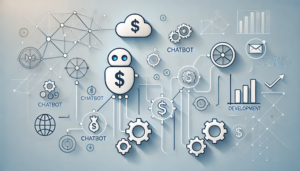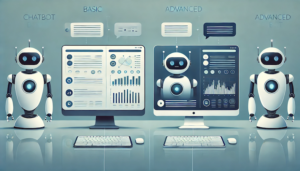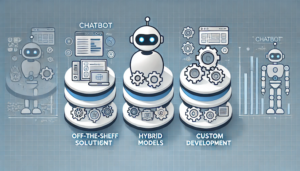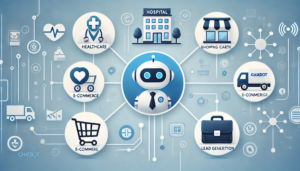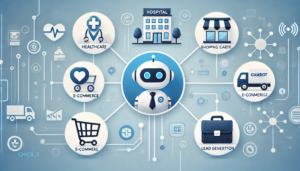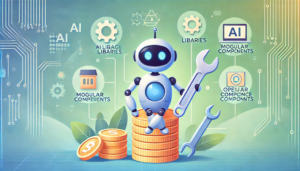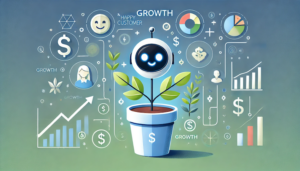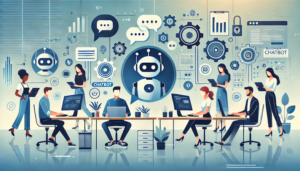Imagine your healthcare organization is fielding calls from patients around the clock. Appointment requests, medication questions, follow-ups—it’s all coming in faster than your team can handle. Patients are frustrated by long wait times, and staff are stretched thin.
You’ve heard about chatbots transforming patient interactions, delivering immediate answers, and streamlining workflows. But as you start exploring the idea, one question inevitably surfaces: How much does it cost to build a chatbot?
This question isn’t as straightforward as it seems; building a chatbot isn’t just about slapping together some code and crossing your fingers. The price can vary dramatically depending on your goals, the complexity of the chatbot, and the tech under the hood. That’s why this guide is here—to break down everything you need to know.
We’ll cut through the fluff and give you a clear, actionable roadmap to understand what goes into the cost of chatbot development, so you can make informed decisions that balance innovation with budget realities. Your chatbot doesn’t just have to work; it needs to deliver real value to your patients and operations. Let’s get into the details.
Key Takeaways:
- Leveraging pre-trained AI models, like Dialogflow or OpenAI’s GPT APIs, can significantly reduce chatbot development cost by eliminating the need for custom training while still delivering advanced capabilities tailored to specific business needs.
- The cost of building a chatbot varies dramatically with features like EHR integration or multilingual support. For instance, basic bots cost $5,000–$15,000, while advanced ones with generative AI and custom workflows can exceed $100,000.
- For those wondering how much does it cost to develop a chatbot, modular development is a cost-effective strategy. Starting with an MVP, such as a HIPAA-compliant chatbot, allows for phased enhancements while controlling initial investment and aligning with long-term goals.
Table of Contents:
- Understanding Chatbot Development Costs: Key Factors
- Feature Set and Its Impact on Chatbot Development Cost
- Development Approaches and Their Pricing Implications
- Estimating the Average Cost of Building Chatbots Across Industries
- Hidden Costs in Chatbot Development and Budgeting Strategies
- Cost-Reduction Strategies Without Compromising Quality
- Investing in Chatbot Development: Long-Term Value for Your Business
- How Topflight Delivers Cost-Effective Chatbot Solutions
Chatbot Development Cost at a Glance
The cost of chatbot development depends on the type of chatbot, its complexity, and the integration requirements. Below is a detailed breakdown of the estimated costs for different types of chatbots.
| Chatbot Type | Estimated Cost ($) | Development Time (Weeks) | Description |
|---|---|---|---|
| Rule-Based Chatbot | $10,000 – $15,000 | 2 – 4 weeks | Simple chatbots that use predefined rules for responses. |
| AI-Powered Chatbot | $35,000 – $80,000 | 5 – 9 weeks | Chatbots that use natural language processing (NLP) and machine learning for dynamic responses. |
| Multilingual Chatbot | $20,000 – $60,000 | 6 – 10 weeks | Chatbots designed to support multiple languages for a global audience. |
| Healthcare Chatbot | $50,000 – $150,000+ | 8 – 12+ weeks | HIPAA-compliant chatbots designed for patient triage, scheduling, and health advice. |
| Generative AI Chatbot | $80,000 – $250,000+ | 12 – 16+ weeks | Advanced chatbots powered by large language models (LLMs) for human-like interactions. |
| Total Estimated Cost Range | $10,000 – $250,000+ | 2 – 16+ Weeks | Varies by complexity and integrations. |
The cost to develop a chatbot in 2024 ranges from $10,000 for basic rule-based chatbots to over $250,000 for advanced AI-driven chatbots, depending on features, integrations, and industry-specific requirements.
Understanding Chatbot Development Costs: Key Factors
When it comes to understanding the chatbot development cost, one thing is clear—there’s no one-size-fits-all price tag. The cost of developing chatbots depends on specific project requirements, and even slight changes in scope or features can have a dramatic impact.
Here’s a breakdown of the key factors that drive pricing decisions and what you need to consider when budgeting for your chatbot.
Functionality and Use Case
The scope of what your chatbot will do is one of the largest factors in determining its cost. Functionality drives everything, from the development timeline to the technical expertise required. For simpler chatbots with limited functionality, costs are naturally lower, but more advanced applications require significant investment.
- Basic Chatbots handle straightforward, scripted tasks such as answering FAQs or managing appointment bookings. These are typically rule-based and cheaper to develop.
- Advanced Chatbots incorporate features like dynamic conversation flows, integrations with other systems (like your EHR or PMS), and advanced processing capabilities.
- Custom Chatbots often handle specific, complex workflows, such as patient triage using targeted symptoms or personalized health tips that involve learning models.
Practical Insight: Before committing to any chatbot project, define your chatbot’s purpose with clarity. Ask yourself, what specific problems are you solving? Features like handling sensitive patient data or integrating with a hospital system are valuable but costly, and avoiding scope creep can keep budgets realistic.
Complexity of the Chatbot
The complexity of your chatbot correlates directly with its cost. A chatbot that performs sophisticated tasks requires more development time and expertise, which drives up the price. Machine learning (ML) and natural language processing (NLP) dramatically elevate complexity—and cost—because they require not just development but also extensive training and testing cycles.
Factors Adding Complexity:
- Multilingual capabilities
- Sentiment analysis for understanding tone or urgency
- Continuous improvement via AI model training
- Real-time syncing with external software like scheduling systems or applications for billing
Practical Insight: Decide early how much complexity you genuinely require. A chatbot with NLP or generative AI doesn’t have to master every possible human nuance—target a focused set of intents and phrases that drive the most value to your organization.
Similarly, if you aim to create a mental health chatbot, the development cost will depend on features like real-time patient monitoring, secure data storage, and natural language processing to provide empathetic and accurate support.
Choice of Platform
Where your chatbot lives will also affect its development cost. There are many platform options to consider, including website-based chatbots, mobile apps, and social media platforms like WhatsApp or Facebook Messenger.
- Web-Based Chatbots are integrated directly into portals like appointment scheduling websites or telehealth platforms. They’re typically more straightforward than mobile app versions.
- Mobile App Chatbots may need to work seamlessly with native app interfaces, which often involve extra customization.
- Multichannel Chatbots that work across platforms (e.g., WhatsApp, SMS, and your website) demand more programming, testing, and maintenance investment.
Practical Insight: Select your platform based on where your users are most active. If 90% of your patient interaction happens on mobile, it might be more effective to focus resources on app-based solutions rather than splitting the budget to support multiple platforms.
Artificial Intelligence Integration
The integration of AI capabilities like natural language processing and machine learning introduces flexibility and intelligence into chatbot solutions but also raises the bar for development costs.
- NLP is key for creating human-like bots capable of engaging in dynamic, fluid conversations.
- Machine Learning models make chatbots smarter over time, capable of getting better at understanding the user’s intent without any manual updates.
- Pre-Trained AI Models (like OpenAI or Google’s AI tools) can significantly cut costs but still require careful customization to fit your organization’s goals.
Practical Insight: Not all AI chatbots need custom-built NLP engines. Using pre-trained models or open-source platforms can be a smart compromise between cost and capability.
Team Expertise and Location
Who builds your chatbot is just as impactful on its price as what it can do. Developers with expertise in chatbot frameworks like Dialogflow, Rasa, OpenAI, or Microsoft Bot Framework command premium rates, especially if you need specialization in healthcare compliance, such as HIPAA regulations.
Practical Insight: Strike a balance. While you don’t want to sacrifice quality for cost, not every chatbot demands a senior developer. Junior or mid-level developers supervised by experienced professionals can often deliver excellent results.
As you may have already gathered, the chatbot development cost question can’t simply be answered with “it’ll be X dollars.” Your costs will depend on decisions you make at each stage of development, from functionality to platform choice to the expertise of the team you hire.
Feature Set and Its Impact on Chatbot Development Cost
One of the biggest drivers of the cost of chatbot development is the feature set your chatbot will incorporate. The functionality you choose—whether basic or custom—determines the development effort, timeline, and ultimately the budget.
1. Basic Features: Affordable and Focused
Chatbots with basic features are designed to handle straightforward tasks and offer a budget-friendly entry point to automated solutions. These chatbots are typically rule-based, using structured conversation flows to provide users with pre-defined answers to common queries.
Examples of Basic Features:
- FAQs Automation: Automatically answering appointment availability, hours of operation, or general policy questions.
- Simple Scheduling: Allowing patients or users to book appointments based on available slots.
- Keyword Detection: Recognizing specific keywords to trigger appropriate responses.
Approximate Cost Range:
Developing a chatbot with basic functionality usually costs $5,000 to $15,000, depending on the complexity of the flows and platforms it supports.
Practical Advice: If you’re just stepping into chatbot development or need a cost-effective solution to solve immediate pain points, start with a basic chatbot. Focus on delivering high-impact but limited functionality—it’s an ideal proof-of-concept for demonstrating value.
2. Advanced Features: Sophistication That Powers Scale
When you move beyond the basics, advanced features elevate what chatbots can achieve. These bots use technologies like generative AI (e.g., chatgpt for healthcare) and integrations with third-party systems to deliver more personalized and dynamic user experiences. However, this added complexity comes at a higher price.
Examples of Advanced Features:
- Dynamic Conversation Flow: Engaging users beyond static scripts with NLP tools that understand intent and reply intelligently.
- Voice Recognition and Text-to-Speech: For hands-free accessibility in solutions like phone-based patient reminders.
- CRM and EHR Integration: Seamlessly connecting with health data platforms to retrieve patient records or process transaction histories.
- Data Analytics Dashboard: Enabling performance tracking and usage monitoring to optimize chatbot workflows.
Conversational AI in healthcare is particularly challenging (and therefore cost-intensive) since PHI protection is required according to the HIPAA guidelines.
Approximate Cost Range:
Advanced chatbots with integrated features generally range from $35,000 to $85,000, depending on the depth of integrations and complexity of the AI functionality.
Practical Advice: Consider advanced features only if they specifically align with your use case and deliver tangible ROI. For example, if patient triaging is a top priority, investing in accurate NLP and medical database integration will be more valuable than a flashy UI.
3. Custom Features: Tailored for Precision
Custom chatbots push the boundaries by being built entirely around your unique requirements. These bots focus on solving a problem specific to your organization and often require extensive research, niche expertise, and iterative development.
Examples of Custom Features:
- Symptom Analysis and Triage: Using machine learning models to suggest care levels based on input symptoms.
- Custom Workflows: Automating multi-step processes, like prescription refills or compliance reminders, that require specialized logic.
- Proactive Notifications: Sending context-aware updates or alerts based on real-time data inputs.
Approximate Cost Range:
Custom chatbots can cost upwards of $80,000 to $150,000+, depending on their scope and the level of innovation required.
Practical Advice: For highly specialized use cases or large-scale organizations, custom chatbots can deliver unmatched value. However, the development process might extend beyond immediate needs, so ensure collaborative planning with your development team to keep it aligned to your budget and timeline.
What You Should Consider When Choosing Features
Here are a few questions to help guide your decision-making process regarding features and their costs:
- What is the primary goal of your chatbot? Is it to reduce overhead with automated responses, improve patient care, or engage large user volumes?
- Can basic features meet your needs? Or do you require the flexibility and intelligence of NLP and machine learning?
- Which integrations are essential? Connecting to existing systems may boost efficiency but also raise the cost.
Matching feature sets with business goals is key to staying within budget without sacrificing impact. Start small, identify measurable outcomes (e.g., reduced call center load by 30%), and incrementally scale with additional capabilities. It’s all about solving problems, not adding bells and whistles.
The feature choices you make will directly influence the cost of healthcare chatbot development, so it’s worth taking the time to clearly define your objectives. Whether you opt for basic, advanced, or custom features, align them with the outcomes you want to achieve while keeping scalability in mind.
Development Approaches and Their Pricing Implications
Choosing the right development approach can significantly impact your AI chatbot development cost and the value you ultimately gain from the solution. Here’s a breakdown to help you weigh your options effectively.
Off-the-Shelf Solutions
Off-the-shelf platforms offer pre-built chatbot frameworks that can be quickly adapted for your use case. Popular examples include platforms like Dialogflow, Microsoft Bot Framework, or even no-code options like Chatfuel. These are efficient if you need something functional without committing to extensive development timelines.
Key Benefits:
- Cost-Effective: Typically priced via subscription models or small upfront development costs.
- Quick Deployment: Minimal adjustments required, which reduces time-to-market.
- User-Friendly Interfaces: Many come with drag-and-drop customization tools for basic workflows.
Drawbacks:
- Limited Customization: The rigid structure may not address niche or complex use cases effectively.
- Dependency on Provider: Relying heavily on a platform may restrict scalability or flexibility in the long term.
Pricing:
Off-the-shelf chatbots generally cost $5,000 to $10,000, depending on the licensing fees and the level of customization needed.
Custom Development
Custom chatbots are built from scratch and tailored entirely to meet your organization’s needs. This approach provides the ultimate flexibility and ensures complete alignment with your systems, processes, and brand.
Key Benefits:
- Full Control: You own the design, functionality, and codebase.
- Advanced Customization: Implement complex workflows, integrate with proprietary systems, or embed advanced NLP and machine learning models.
- Scalability: Easily adapt and grow functionalities as your business evolves.
Drawbacks:
- High Initial Investment: The extensive involvement of experienced developers and AI specialists drives costs higher.
- Longer Timelines: Built-from-scratch projects take more time to design, develop, and test.
Pricing:
Custom chatbots typically start at $50,000 and can exceed $100,000, depending on the scope and features.
Hybrid Models
A hybrid approach combines pre-built chatbot frameworks with specific customizations. It’s a middle ground for organizations looking to maximize functionality without committing to a fully custom solution.
Key Benefits:
- Cost Savings: Lower than full custom development but still allows moderate customization to meet unique needs.
- Quicker Deployment: Leverages existing frameworks to cut development time while tailoring specific functions.
- Flexibility: Balances the affordability of off-the-shelf solutions with the innovation of custom capabilities.
Drawbacks:
- Shared Ownership: Using a framework may limit how much control you have over the architecture.
- Customization Limitations: While it allows moderate customization, extreme tailoring may not always be feasible.
Pricing:
Hybrid solutions usually range between $15,000 and $50,000, influenced by the scope of customizations and integrations.
How to Choose the Best Approach for Your Needs
Here are some critical considerations while deciding on a development approach:
- Budget Constraints: Off-the-shelf solutions keep costs low. If budget is flexible, consider hybrid or custom models.
- Urgency: Off-the-shelf saves you time, but custom development unlocks long-term potential.
- Complexity of Use Case: Highly specialized needs or industry-specific compliance will demand more tailored solutions.
- Scalability: If your chatbot requirements are likely to grow, choose an approach that leaves room for expansion.
While off-the-shelf solutions offer a quick and affordable launch, custom development ensures a personalized and robust approach for more demanding use cases. Hybrid models balance the best of both worlds, delivering tailored results without breaking the bank.
Estimating the Average Cost of Building Chatbots Across Industries
When determining the average cost of building chat bots, the type of chatbot you need, its intended audience, and the business goals play significant roles in shaping your budgeting expectations.
Whether the focus is healthcare, e-commerce, lead generation, or customer service, each industry brings distinct requirements that influence development expenses. Below, we’ll break down typical cost ranges by industry, offering a clearer picture of what to expect when planning your chatbot project.
1. Customer Service Chatbots
Customer service chatbots are among the most popular applications, helping companies handle inquiries efficiently while reducing operational costs. These chatbots often handle FAQs, initiate returns, or escalate complex cases to live agents.
Cost Range:
- Basic bots with simple logic and predefined responses start at $10,000 to $15,000.
- More advanced bots featuring sentiment analysis or multilingual support could range between $25,000 and $50,000.
Cost Drivers:
- Integration with CRMs such as Salesforce or Zendesk increases complexity, and consequently, the cost.
- Sophisticated AI for understanding emotional tone or handling nuanced customer inquiries adds to the budget.
Practical Insight: Assess your customer inquiry volume first. If 80% of inquiries are repetitive (e.g., tracking orders), starting with a basic bot is highly cost-effective.
Related: App Development Costs: The Complete Breakdown
2. Healthcare Chatbots
Healthcare bots like the MiLife AI Chatbot focus on offering tailored support, such as appointment scheduling, medication reminders, and patient triage, while ensuring compliance with regulations like HIPAA.
Cost Range:
- HIPAA-compliant solutions typically start at $50,000 and may scale beyond $100,000, especially when integrating with EHR systems.
- Bots aimed solely at appointment scheduling or FAQs for clinics fall in the $20,000 to $40,000 range.
Cost Drivers:
- Data security and compliance features escalate costs.
- The need for advanced NLP to precisely interpret medical questions adds significant value (and cost).
Practical Insight: If your healthcare chatbot targets simple administrative tasks like scheduling, a mid-range solution should suffice. However, for bots managing sensitive patient data, investing in compliance and AI accuracy is non-negotiable.
3. Chatbots for Lead Generation
Lead generation-focused chatbots are designed to guide prospects through the sales funnel, qualify leads, and even pitch products or services.
Cost Range:
- For simpler lead qualification bots that embed in websites, costs range between $15,000 and $25,000.
- Fully customized versions with engagement tools like live chat escalation or multilingual capabilities may push costs toward $30,000 to $50,000.
Cost Drivers:
- Custom integration with marketing platforms like HubSpot or Marketo can increase costs.
- Multi-stage conversation flows designed to nurture leads take additional development time.
Practical Insight: If you’re in B2B sales, combine chatbot functionality with CRM integration to get the most out of your investment. Customization in question flows ensures higher conversion rates.
4. E-Commerce Chatbots
E-commerce chatbots focus on enhancing shopping experiences, resolving customer issues in real time, and suggesting personalized recommendations.
Cost Range:
- Basic chatbots for product FAQs and order tracking typically cost $10,000 to $20,000.
- Advanced bots capable of cross-selling, upselling, and real-time inventory checks can cost between $25,000 and $50,000.
Cost Drivers:
- Personalization features using AI to analyze customer preferences significantly affect pricing.
- Integration with e-commerce platforms, such as Shopify or WooCommerce, adds complexity.
Practical Insight: For small-to-medium-sized stores, focus on bots that handle order tracking and FAQs to reduce overhead. Larger operations may benefit from investing in personalization algorithms for higher ROI.
Other Industries and Use Cases
Chatbots also extend into niches like education, travel, nonprofit services, and more, each with varying costs based on specialized needs.
- Education: Bots for tutoring or student support—$15,000 to $30,000, depending on conversational complexity.
- Travel: Conversational bots managing bookings or itinerary updates—$20,000 to $40,000.
- Nonprofits: Bots for donor engagement or awareness campaigns—starting at $10,000 for basic setups.
The cost to make a chatbot varies widely depending on its application, sophistication, and integration needs. A healthcare chatbot with compliance and advanced features will naturally cost more than a basic e-commerce customer service bot, but both drive immense value when aligned with business goals.
Hidden Costs in Chatbot Development and Budgeting Strategies
When budgeting for chatbot development, the visible costs typically dominate attention—development time, feature creation, and initial deployment. But what often gets overlooked are the hidden costs that crop up post-launch.
These can significantly impact the long-term cost to run and maintain your chatbot. Here’s what you should consider when estimating the cost of building a chatbot and planning its lifecycle expenses:
Operational Expenses
After your chatbot goes live, there are recurring operational costs to account for. Hosting, server usage, and API calls can add up quickly, especially if your chatbot is handling a high number of conversations or using intensive AI models. If the chatbot integrates third-party APIs—ranging from scheduling software to EHR—you may pay subscription or per-call fees. Be sure to:
- Estimate monthly hosting and third-party service costs.
- Negotiate usage-based pricing with vendors to prevent overages.
- Monitor and optimize your chatbot’s performance to reduce unnecessary resource consumption.
Maintenance and Support
AI chatbots are not “set-it-and-forget-it” installations. Regular updates are essential to accommodate user feedback, improve natural language processing (NLP) capabilities, and patch security vulnerabilities. Consider:
- Allocating 15–20% of the initial project budget annually for maintenance.
- Investing in monitoring tools to pre-empt downtime and ensure operational continuity.
Scalability Costs
If your chatbot gains traction, you’ll need a plan to scale without sacrificing performance. This could mean upgrading hosting plans, re-architecting cloud deployments, or retraining models with larger datasets. Scalability costs often include:
- Higher-tier cloud infrastructure fees.
- Salaries for additional team members to manage expanded chatbot capabilities.
- Costs of retraining AI models to handle new scenarios or languages.
Compliance and Regulatory Expenses
Especially in healthcare, compliance with regulations like HIPAA can introduce additional costs. These include securing sensitive user data, implementing encryption measures, and undergoing regular audits. Missteps here can lead to penalties far exceeding the chatbot’s development cost. Suggestions:
- Partner with a vendor experienced in industry compliance.
- Factor audit and legal support fees into your budget.
Budgeting Strategies to Stay Ahead
To avoid surprises, be diligent during the planning phase.
- Use a total cost of ownership (TCO) model to estimate not just the development cost but also the ongoing cost to run the chatbot.
- Build a reserve fund for unexpected upgrades or emergency fixes.
- Opt for scalable infrastructure solutions (e.g., AWS Auto Scaling) to control how much you pay as usage increases.
Addressing hidden costs upfront ensures your chatbot doesn’t just launch seamlessly but sustains value over time, delivering meaningful results without breaking the bank.
Cost-Reduction Strategies Without Compromising Quality
Reducing costs in chatbot development doesn’t mean cutting corners. It’s about making strategic decisions that maximize efficiency and maintain high-quality outcomes. If you’ve wondered how much does it cost to implement a chatbot, and whether there’s wiggle room to save, here’s how you can balance cost and impact effectively.
1. Leverage Pre-Trained AI Models
Building a chatbot from scratch, especially one with sophisticated AI capabilities, can be resource-intensive. A practical alternative is to use pre-trained AI models like Google’s Dialogflow, IBM Watson, or OpenAI’s GPT APIs. These solutions come with baked-in intelligence, saving you from the costs of training a model from zero. Here’s how you can leverage them:
- Use pre-built natural language processing (NLP) libraries to handle common queries.
- Fine-tune existing models on your specific data instead of training entirely new ones.
- Choose platforms that offer affordable pricing models based on usage, helping you scale incrementally.
2. Adopt Modular Development
Rather than building a monolithic chatbot, modularity allows you to develop components in phases. By prioritizing key functionalities first, you can control costs while driving early value. With this approach, you:
- Start with a minimum viable product (MVP) that focuses on essential features.
- Add advanced functionalities—such as integrations with EHRs or payment gateways—as budgets allow.
- Reuse and repurpose existing code modules for faster implementation across different platforms.
3. Choose the Right Pricing Model
Vendors and cloud platforms usually offer multiple pricing models, such as pay-per-usage or flat licensing fees. Selecting the right pricing structure is crucial for long-term cost control. Consider:
- Pay-per-interaction models for chatbots with sporadic usage patterns.
- Subscription-based pricing if you expect high and consistent usage to reduce per-unit costs.
4. Utilize Open Source Solutions
For certain chatbot requirements, open-source frameworks like Rasa or Botpress can eliminate licensing fees, slashing development costs. However, they may require in-house expertise for deployment and maintenance, so weigh initial savings against potential operational overheads.
5. Plan Scalability Thoughtfully
Scalability often introduces unexpected costs down the road. During the initial development, make scalability part of the strategy by:
- Opting for cloud services with features like autoscaling or usage-driven pricing.
- Designing architecture that allows adding or upgrading features without disrupting existing functionality.
6. Streamline Integrations
Ad hoc integrations with third-party systems can pile up costs. Instead, focus on standardized integration efforts:
- Use middleware or platforms that simplify multi-system connectivity.
- Opt for APIs built to support scalability and flexibility without heavy customization.
Investing in Chatbot Development: Long-Term Value for Your Business
When weighing the chatbot implementation cost, it’s critical to evaluate the long-term value it brings. Beyond the initial investment, a well-planned chatbot delivers measurable returns across multiple dimensions.
Whether you’re wondering how much does it cost to develop a chatbot or assessing its role in meeting your business needs, here’s why the investment pays off:
Enhanced ROI
Chatbots optimize processes that traditionally require heavy human resources. Automating routine tasks—like patient intake, appointment scheduling, or FAQs—allows your team to focus on higher-value activities, translating to significant cost savings.
Improved Operational Efficiency
With the right technology, a chatbot can act as a 24/7 support system, reducing response times and eliminating bottlenecks. For example, integrating predictive analytics into your chatbot enables proactive engagement, such as preempting appointment cancellations or flagging overdue follow-ups—streamlining workflows and boosting productivity.
Elevated Customer Satisfaction
Effective chatbots enhance user experience by providing quick, accurate, and seamless support. A responsive chatbot can handle inquiries without keeping users waiting, which is especially valuable in high-pressure environments like healthcare. The result? Stronger engagement and loyalty.
A Forward-Focused Business Asset
Investing in a chatbot isn’t just about solving immediate needs—it’s about future-proofing your operations. Prioritize features and integrations that align with your evolving objectives to ensure your chatbot adapts and delivers enduring value.
How Topflight Delivers Cost-Effective Chatbot Solutions
When it comes to addressing chatbot development cost concerns, Topflight stands out by delivering solutions that balance innovation, compliance, and affordability. The success of the MiLife AI Chatbot is a prime example of how we tackle complex challenges while staying focused on the ultimate goal—creating value.
MiLife AI Chatbot: A Scalable, HIPAA-Compliant Solution
Goldie Floberg faced an immense burden with caregivers needing to manage over 1,300 pages of policies and client information. Our team delivered a hands-free, AI-powered chatbot that transformed caregiving by offering real-time access to critical data. Here’s how we minimized development costs while maximizing impact:
- Smart Leveraging of AI
Instead of training an AI model from scratch, we adopted retrieval-augmented generation (RAG), which ensured accurate data retrieval without costly or time-consuming NLP model training. This approach also combated common AI challenges like hallucinations by grounding responses in real data. - Efficient Modular Development
We prioritized an MVP (Minimum Viable Product) featuring core functionalities like conversational AI, task reminders, and secure data access. This phased development approach allowed Goldie Floberg to get value quickly, while advanced features, like EHR integration, could be added incrementally within budget. - Compliance-Centered Design
Healthcare chatbots must adhere to strict regulations like HIPAA. To stay compliant without driving up costs, we implemented de-identification mechanisms using tools like Azure OpenAI and BastionGPT, ensuring all patient health data remained secure.
Proven Outcomes That Save Money
- The implementation led to a significant reduction in medication errors, which helped lower healthcare risks and associated costs.
- Staff satisfaction and efficiency saw notable improvements, contributing to a high NPS.
- The scalable backend enabled future expansion for multi-tenancy, spreading the chatbot development cost across potential stakeholders.
Need help navigating chatbot pricing and selecting the right development model? At Topflight, we merge technical precision with cost-efficiency to create chatbots tailored to your requirements. Connect with us today and explore what’s possible within your budget!
Frequently Asked Questions
How much does it cost to develop a basic chatbot vs. an advanced chatbot?
A basic chatbot typically costs $10,000–$30,000, while advanced chatbots with AI, NLP, and custom integrations can range from $50,000 to $150,000 or more, depending on complexity.
Does the choice of chatbot platform affect the development cost?
Yes, platform selection influences cost. Custom-built platforms require higher budgets, whereas leveraging tools like Azure or AWS can reduce initial costs but may incur ongoing fees.
How much does AI and NLP integration add to the cost of a chatbot?
AI and NLP integration can add $10,000–$50,000+ to development costs. Pre-trained AI models keep costs lower, while training custom models significantly raises expenses.
What are the typical hourly rates for chatbot developers?
Hourly rates vary by expertise and location, ranging from $50–$150 per hour in the US or Europe, with lower rates available in other regions without compromising quality.
